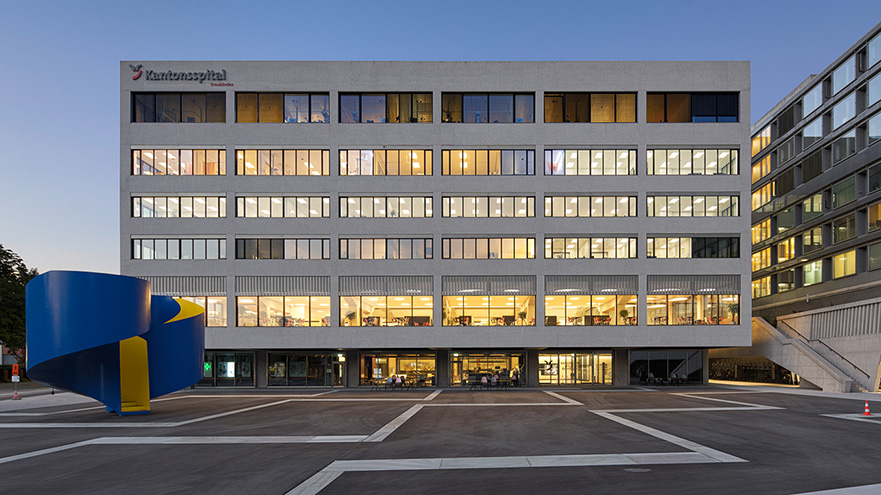‘Rethinking hospital operations’
Tariffs that do not cover costs and limited resources have put the healthcare system under enormous pressure. Through process automation, Kantonsspital Graubünden is reducing administrative burdens, improving data quality and creating space for what really matters: high-quality, safe care.
06 June 2025, Text: Christoph Widmer 4 min
With a clear digitisation strategy backed
Tariffs that fail to cover costs, ever-increasing regulatory requirements and thus increasing administrative costs that are not reimbursed, and a challenging staffing situation have left many hospitals in Switzerland facing structural challenges. In this situation, the question of how internal processes can be made more efficient without compromising the quality of care comes to the fore. Process automation is increasingly becoming a strategic factor – not only for efficiency improvement measures, but also as a means of lightening the workload of highly qualified specialists.
Kantonsspital Graubünden (KSGR) was quick to take action: with a clear digitisation strategy backed by the Executive Board and supported by cantonal funding, KSGR is pursuing the development of digital structures with measurable benefits. Primary objective: cost savings and workload relief for in-house staff. Markus Müntener, Head of digital Process Development at KSGR: ‘We don’t want to save on staff, we want to gain time – so we can provide better patient care without overloading on work.’
RPA: Software robots perform routine tasks
A key element in making hospital work more efficient is the introduction of robotic process automation (RPA). RPA refers to software robots (bots) that perform rule-based, repetitive tasks such as extracting and transmitting data between IT systems. The advantage: RPA accesses existing user interfaces, software and systems like a human user without the need for complex interfaces. This reduces the implementation effort and enables quick results.
With its technical expertise and understanding of healthcare, Swisscom supported KSGR in the implementation of the project. Swisscom’s support went beyond technical development to encompass methodology as well – for example, with workshops on process analyses, templates for evaluating automation potential and specific implementation recommendations. The actual selection and prioritisation of the processes were carried out by internal departments in order to reflect the operational reality. After all, the first use of RPA was to be for administrative processes. ‘The biggest challenge in the field of nursing and medicine is the high complexity of the processes – during discharge, for example, which proceeds differently depending on the diagnosis and treatment,’ says Müntener. ‘That’s why we deliberately started with standardised administrative processes, where we can reliably use RPA to automate without undue risks.’
Fast, precise, automatic
One use of RPA is for automated checking and updating of patient master data. Where previously information had to be transferred manually from one system to another, today the RPA bot searches for the current data and automatically updates it. This reduces invoicing errors and saves post-processing time.
Müntener mentions cost approval for out-of-canton patients as another use case. In the past, employees had to enter data manually every day. Today, a bot does this fully automatically. The archiving of laboratory reports from external providers has also been automated. Instead of it being a manual assignment task that takes half a day, the system uses optical character recognition to identify the order number and automatically assigns the report correctly.
In addition, KSGR is already testing ways to support doctors with AI. One noteworthy project is the Patient Summary. It uses an LLM (large language model) to summarise relevant medical information from dozens of documents. ‘A patient’s medical history can go back years and consist of up to 100 documents – from laboratory examinations to medical history forms to admission and discharge reports,’ explains Müntener. ‘Our automated patient summary delivers summaries of entire medical records in seconds.’
The first uses of automation are also being implemented in the nursing unit. For example, vital signs are transferred automatically when patients are transferred to other units.
Technology alone is not enoug
Precise preparation is required for targeted process automation in the healthcare system. According to Markus Müntener, the biggest challenge is choosing the right processes. This requires proximity to day-to-day work and a deep understanding of the workflows. Close collaboration with the departments is also important, he notes. Processes must not be considered in isolation, but must remain consistent with the overall context. Acceptance of the new solutions is particularly crucial in the medical context. ‘Our doctors need to be able to rely on automated information. Trust is everything here.’
RPA tips for service providers:
- Consider processes holistically: Automation must be considered in the overall context of processes. Digitalisation is only useful if you know the entire process.
- Prioritise suitable processes: Technical feasibility, potential benefits and organisational implementation must all be in harmony.
- Take reservations seriously: Acceptance is crucial, particularly in medical contexts. Transparent communication builds trust.
- Build up internal skills: The operation and further development of RPA solutions requires internal skills on site – external consulting alone is not enough to continue successfully automating processes in the long term.
Time gain of 5,000 hours
In addition to numerous ‘internal’ ICT bots, seven bots are also in productive use at KSGR. With measurable success: ‘We automate over 5,000 hours of manual work every year,’ says Müntener. The time saved benefits profitability, the quality of care and job satisfaction. The automation also significantly optimises the hospital’s operational processes, he says, with better data quality and fewer sources of error.
KSGR not only benefits internally from its progress – it also sees itself as a driving force in the canton. Cantonal support for digitisation makes it possible to make developed solutions available to other hospitals as well. The aim is to benefit from shared experiences, systematically exploit existing potential and thus sustainably strengthen healthcare provision throughout the canton of Grisons.
The example of KSGR illustrates that process automation is not an end in itself, but a strategic resource with which hospitals can prepare themselves for the future even under challenging conditions. It not only boosts efficiency, but also the capacity of what is ultimately most important – high-quality, safe care and less pressure on specialists.

